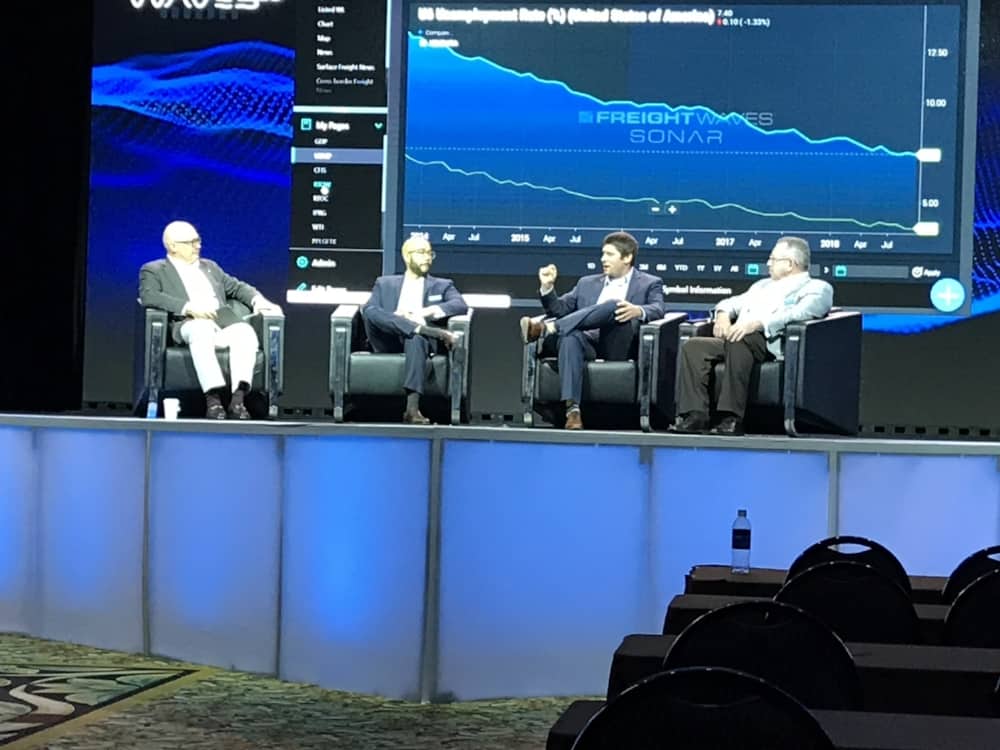At MarketWaves18 in Grapevine, Texas, on Tuesday, Donald Broughton moderated a discussion with economist Ibrahim Bayaan, and analysts Dean Croke, and Daniel Pickett.
“This may turn out to be the strongest year since the Great Recession if you look at GDP at least, which is very impressive if you think about it,” began Bayaan. “Most people will refer to the unemployment rate, but I tend to look at things on the broader market. People previously on the sidelines in the labor market have been brought back in. There’s not a lot of excessive slack in the economy. What that tells me you’re in a late cycle back to normal. Not that we’re hitting a recession any time soon, but things are going to moderate back I think, and we’ll see 2018 as a standout year,” he said.
“I would agree with that,” said Pickett. “If you slow from 100 miles per hour to 70 you wonder what’s going on. One of the things I watch is the lumber movement on the rail. That can be a good canary in the coal mine, but for now it’s still signaling strength.”
“An early indicator is also intermodal growth. It’s still in line with that 2.5 or 3% GDP growth. Everything we’re seeing indicates that we’re going to keep going at similar levels,” said Pickett.
“I love what you’re saying about lumber data, that’s something I’ve been following for years,” said Broughton. “It tells you a lot in terms of construction and housing starts.”
“Along the same lines, I see something a little different for Q1,” said Dean Croke. “I see some vectors falling to 2010 levels, such as used truck prices. The inflow of container freight is going to have a drop off in freight volumes. I see a challenging time at the beginning of the year, especially if you’re a truck driver. To Ibrahim’s point, I see a lot of continued strength.”
“As the OEMs start to put out their high volumes but they’re also getting cancelations now, and you’ll start to see a loosening in capacity,” said Croke.
“Another important diagnostic is something people can track in SONAR. It’s a cyclical industry,” said Broughton.
“The forecast for tomorrow is yesterday,” agreed Pickett.
“There’s a bottom end and a top end of the cycle and it’ll be interesting to see how people use their pricing power, and how we can maybe help them better manage it,” said Broughton.
“I see more carriers in the market and people understanding the market better with their resources. I’m not sure demand will change, but their response to the data will be interesting to see,” said Croke. “Less cash flow management. More about their yields rather than their cost per mile. It all opens up the market for everyone.”
“The only thing that has me worried is inflation. It started in transportation, when will it hit the consumer? We’ve seen epic inflation in the cost of freight, which will translate to manufacturing and then the consumer. Will that happen over Q2 or Q3?” said Pickett.
“I look at manufacturing and construction too,” said Bayaan. “And 2018 was strong for retail and the appetite is still strong from a consumer demand perspective. The Federal Reserve will take a bit of steam away. Manufacturing looks positive, but tariffs will have an effect. I’m seeing a strong 2019, just not as strong as 2018. We can also look at global growth conditions. This year is a lot like 2014 where manufacturing was strong but then the price of oil fell and manufacturing slowed. We’re now seeing oil falling again, but probably not as strongly as it fell in 2015.”
“As for capacity the labor market for truckers has been tight for quite some time,” Bayaan went on. “How is employment doing there? Employment hasn’t been bad. Demand remains strong even as capacity is tight. Carriers are starting to address some of the quality of life things that drivers endure. Capacity should gradually expand over the course of 2019.”
“There should be less pressure on the trucking market as conditions gradually ease,” said Bayaan.
“The industry is pulling in more drivers by giving them higher wages. And one of the impacts of the ELD Mandate is that drivers are getting more out of their day and their hours. More drivers in the market and better use of their time at these docks,” said Pickett.
“It’s funny, the ELD Mandate is like the Y2K of the industry. It was the most analyzed and anticipated event in its history,” said Broughton.
“Shippers may be the last to see the changes, but I think they’ll find it easy to find freight especially in the new year,” said Croke. “A few things will drive capacity. Fleets adapting the technology to getting more out of their drivers for their time. We can see a good quality of life for drivers, getting back home each night. We’ve also seen the HOS and the regulations the FMCSA has been criticized for changing. We’d like to see the flexibility within the ELDs as just as much as there was with paper logs. There’ll be some evening out as smaller markets find efficiencies to keep up.”
While Croke believes the current administration is playing for keep when it comes to the tariff trade war, Pickett said, “I wouldn’t rule out that they’ll change things at the last minute.” Bayaan also isn’t so sure that they’ll last. “There’s a lot of brinksmanship that goes on,” he said. “There’s a feeling that a lot of the escalation is a lot of talk. When the American economy starts really hurting, you’d think cooler heads will prevail. There’s a chance all this gets resolved and we’ll see even more growth.”
“I think we all more than secretly hope this is all just a game of chicken,” added Broughton.











